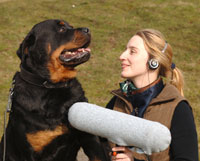- 23 March 2006
You’d have to be barking to volunteer for this research

Anna with volunteer Marley the Rottweiler
Can you tell if a dog's bark is worse than its bite? Possibly not, but it could be that dogs are able to weigh up each other just by hearing each other's growls.
Anna M. Taylor, a DPhil student in the Centre for Mammal Vocal Communication Research at the Department of Psychology at the University of Sussex, has started a project on dog vocal communication, funded by the Biotechnology and Biological Sciences Reasearch Council (BBSRC).
Supervised by mammal communication specialists Dr David Reby and Dr Karen McComb, Anna is planning to record the woofs and growls of hundreds of dogs. And to achieve that, she is looking for around 300 canine volunteers.
Dog owners are invited to sign up for the experiment by registering their dog's details with Anna via email or by letter, specifying the breed, age and sex of their dog, plus contact details for the owner. Anna will then advise the owners when a recording session is due. Anna's progress as her research gets properly under way can also be viewed at a special web site, www.vocaldog.com .
"To get a good sample, I'll need dogs of all shapes and sizes," says Anna. "I'd also like the dogs to be friendly and not averse to being handled. And they need to be noisy." Anna will also film, weigh and take the head measurements of each dog, to provide valuable data for her investigation of how and why dogs use sound to communicate.
To begin with, Anna plans to isolate and analyse growls emitted in each recording. Dog growls are made up of sound components called formants (formants form the basis of vowel sounds in human speech). These formants are believed to convey a lot of information about the dog making them, including body size, sexual aggressiveness or weight of an individual - important information for animals competing for territory, food or a mate.
Anna will investigate whether the formants are related to the length of each dog's vocal tract - the space that runs from the nasal and mouth cavities to the larynx in the throat and which produces the formants. All of the information collected should allow Anna to verify whether there is a link between the formant produced and size/ type of each dog - and whether this information is available for human and canine listeners.
In the longer term, Anna is hoping that her research will feed into a better understanding of vocal communication in dogs. She says: "There are evolutionary implications in all of this, to do with the domestication of the dog. Co-evolutionary theory suggests that the evolutionary history of humans and dogs is inextricably linked, and it may be that domestic dogs vocalise primarily for their human companions. It would be interesting to test this theory, for example, by modifying the recordings, then playing them back to humans and other dogs to see how they respond, hopefully showing which acoustic notes are important for which species.
"Owners like to think they know what their dog is saying when it barks. Hopefully, this research will help to reveal scientifically what man's best friend is really communicating."
Notes for editors
Anyone wishing to volunteer their dog to help with Anna's research, should register by sending an email to admin@vocaldog.com or write to Anna M. Taylor, Department of Psychology, University of Sussex, Brighton, BN1 9QH.
Registration is also possible at www.vocaldog.com
For interviews etc, contact Maggie Clune or Jacqui Bealing in the University of Sussex Press office. Tel: 01273 678209 or email press@sussex.ac.uk